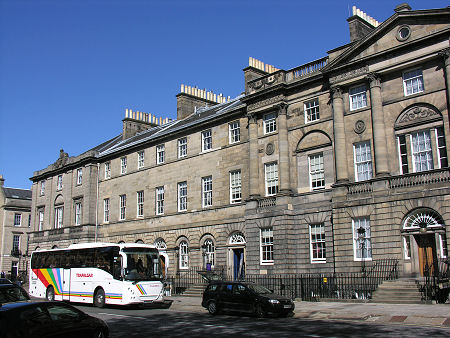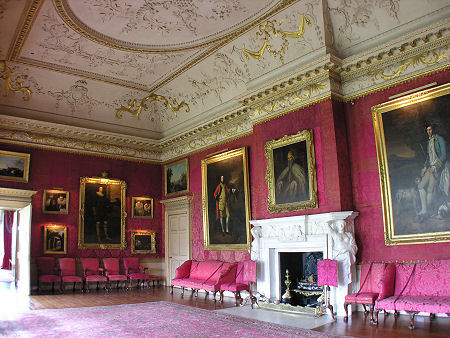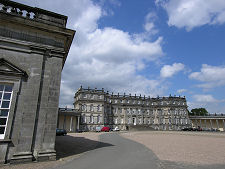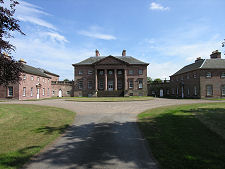 The North Side of Edinburgh's Charlotte Square |
Robert Adam lived from 3 July 1728 to 3 March 1792. He was the most famous of the Adam family of architects, which also included his father William Adam and his brothers James Adam and John Adam. Robert Adam made his name in the related fields of architect, interior design and furniture design. He is considered by many to be the greatest architect of the late 1700s, a leader of the neoclassical revival in England and Scotland from around 1760 until his death. The wider picture in Scotland at the time is set out in our Historical Timeline.
Robert was born in Kirkcaldy in Fife. He studied at the Royal High School in Edinburgh, before going to Edinburgh University in 1743. His studies were interrupted by illness and by the 1745 Jacobite Rising. In 1746, Robert joined his elder brother, John Adam, as an assistant to his father. After their father's death in 1748, the two brothers became partners in the family business, now known as "Adam Brothers."
Their first major commission was the completion of the reconstruction and remodelling, begun by their father, of Hopetoun House, Queensferry. This was finally completed in 1767.
In 1754, Robert went to Europe on a grand tour of France and Italy, studying classical architecture and honing his drawing skills. His art tutors on his travels included French architect Charles Lois Clérisseau and architect and archaeologist Giovanni Battista Piranesi. During this journey, he studied intensively the ruins of Diocletian's palace at Split in Dalmatia, which led to his publication of his book The Ruins of the Palace of Diocletian in 1764.
Robert returned to Britain in 1758 and set up business in London with his brothers. They became celebrated for their complete schemes that involved the design, the decoration and the furnishing of houses. Robert was responsible for a number of buildings in the Palladian style, but he went on to evolve a distinctive approach that incorporated a range of classical styles.
In 1761, Robert Adam was appointed Architect of the King's Works, jointly with Sir William Chambers. In the same year he became a member of the Society of Antiquaries; and he had been elected to membership of the Royal Society of Arts in 1758.
Robert Adam died in 1792 at his home, 11 Albermarle Street, London, after a blood vessel in his stomach burst. He was 64. He was buried in Westminster Abbey. He left nearly 9,000 drawings, most of which were purchased by the architect John Soane and are now on display at the Soane Museum in London.
Amongst the many Scottish buildings attributed to Robert Adam are Register House, Edinburgh; Gosford House, East Lothian; Ballochmyle House, Ayrshire; Mellerstain House, Kelso; Culzean Castle, Ayrshire; Edinburgh University Old College; the north side of Edinburgh's Charlotte Square; Wedderburn Castle, Duns; Airthrey Castle, Stirlingshire; the interior of Archerfield House, East Lothian; Yester House, East Lothian; and... the list is a long one, longer still if you include projects led by other members of the Adams family in which Robert is thought to have had a hand. These include Paxton House in Borders; parts of Fort George; and Mavisbank in Midlothian. Truly a man whose influence and ideas have survived, or even grown, over the centuries since his death.
 The Red Drawing Room at Hopetoun House |


